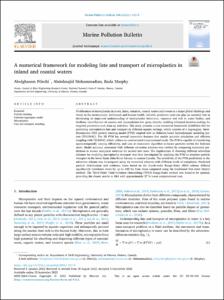A numerical framework for modeling fate and transport of microplastics in inland and coastal waters.

View/
Average rating
votes
Date
2022Author
Pilechi, Abolghasem
Mohammadian, Abdolmajid
Murphy, Enda
Metadata
Show full item recordAbstract
Proliferation of microplastics in rivers, lakes, estuaries, coastal waters and oceans is a major global challenge and
threat to the environment, livelihoods and human health. Reliable predictive tools can play an essential role in
developing an improved understanding of microplastics behaviour, exposure and risk in water bodies, and
facilitate identification of sources and accumulation hot spots, thereby enabling informed decision-making for
targeted prevention and clean-up activities. This study presents a new numerical framework (CaMPSim-3D) for
predicting microplastics fate and transport in different aquatic settings, which consists of a Lagrangian, three dimensional
(3D) particle-tracking model (PTM) coupled with an Eulerian-based hydrodynamic modeling system
(TELEMAC). The 3D PTM has several innovative features that enable accurate simulation and efficient
coupling with TELEMAC, which utilizes an unstructured computational mesh. The PTM is capable of considering
spatio-te.....
Journal
Marine Pollution BulletinVolume
182Issue
Article 114119Page Range
15pp.Document Language
enSustainable Development Goals (SDG)
14.aMaturity Level
MatureDOI Original
https://doi.org/10.1016/j.marpolbul.2022.114119Citation
Pilechi, A., Mohammadian, A. and Murphy, E. (2022) A numerical framework for modeling fate and transport of microplastics in inland and coastal waters. Marine Pollution Bulletin, 184:114119, 15pp. DOI: https://doi.org/10.1016/j.marpolbul.2022.114119.Collections
The following license files are associated with this item:
Except where otherwise noted, this item's license is described as Attribution-NonCommercial-NoDerivatives 4.0 International
 Repository of community practices in Ocean Research, Applications and Data/Information Management
Repository of community practices in Ocean Research, Applications and Data/Information Management
